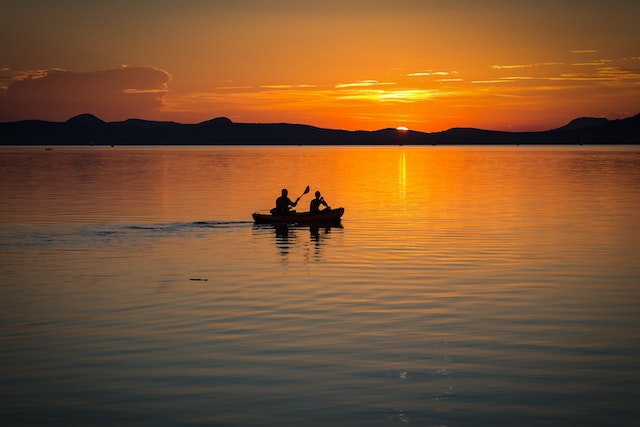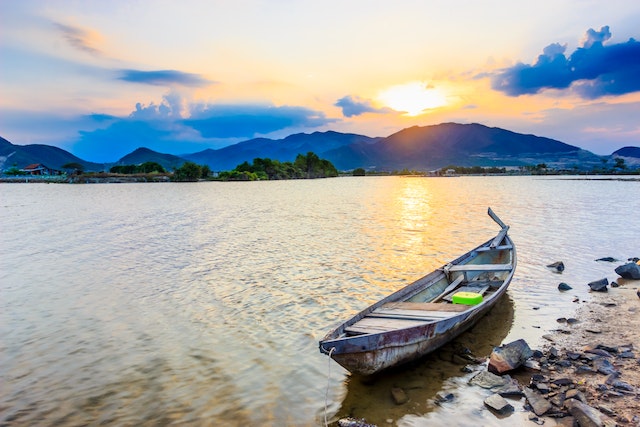The outdoors are an enchanting realm where the most astonishing sights of nature unfold, from mesmerizing waterfalls, fascinating sunsets to serene waters of lakes, rivers and otherworldly coastal shores, there’s just so much to explore for the travelers.

In the vast playground, there are more than a many watery or aquatic destinations or spots which one must wander through at least a couple times in life. And the best way to glide across the serenity and calmness of the waters is by: a kayak and a canoe.
Today, we talk about Kayak vs Canoe and journey through to discover the differences between the two water activities, their types, pros and cons, tips for exploration and where to experience them.
In this blog post, you will find:
- Major Differences between a Kayak and a Canoe
- Quick History
- Pros and Cons
- Tips for which one to choose
- Essential Gear for Kayaking vs Canoeing
- Best places to experience Kayaking vs Canoeing
Table of Contents
Kayak vs Canoe: Major Differences
Both these vessels have a rich history, diverse types and different utilizations and characteristics, but the common thing remains to be the unique gateway they both offer you to get up and close with the natural world.
Let’s just straight away dive into why you’re here – to get the major differences between the two water sport activities:
Design & Structure
One of the most out there feature which differentiates a kayak vs canoe is the design and structure of the two water vessels.
Canoes are basically open-top boats with an elongated shape and they are designed for seating more than one or two passengers i.e. you can have the experience along with you family or friends.

On the other hand, Kayaks are more enclosed and low-profile vessels and are designed for one or maximum two individuals. These are basically great for solo adventures or a couple-experience.
Paddling Techniques
The second major difference between a kayak and a canoe is their different paddling methods or techniques. And understanding these techniques is crucial for efficient and enjoyable experiences.
While canoes are paddled with a single-bladed paddle while sitting or kneeling, kayaks use a double-bladed paddle with a sitting position. The technique are quite similar, but the paddle blades make it a little different for both the vessels.

Kayak Paddling Technique:
- Step 1: Grip the paddle with both hands, positioning each hand evenly on both sides.
- Step 2: With slightly bent arms, submerge the blades one by one on either side of the boat, simultaneously.
- Step 3: Pull the paddle blades through the water. Use your torso and core muscles to move the vessel forward towards the water. Once the stroke is done, pull out the blades to keep the movement smoother.
- Step 4: Keep the kayak moving straight by stroking the waters alternatively on each side of the vessel. Make a rhythmic pattern to keep the venture smooth.
Canoe Paddling Technique:
- Step 1: Grip the paddle with both hands and make sure to keep a shoulder-width apart distance between your hands.
- Step 2: Reach forward with your paddle blade into the water. Your hands must be at eye-level during this.
- Step 3: Using your torso and core muscles, pull the paddle towards your hip in a straight line. Avoid using just your arms but make sure to move your hip and torso when you paddle. You need to pull the canoe forward by pushing the water back.
- Step 4: Make sure to keep switching sides and do the paddling one by one on each side. This makes sure your boat doesn’t veer to one side.
#Remember: Achieving smooth paddling takes practice. You can try out some kayaking or canoeing at calmer waters before you head to more stronger waters. Once you have enough skills and confidence, paddling will be like second nature to you.
Use & Purpose
When we talk about the Kayak vs Canoe differences, we must also discuss and understand the primary purpose that these fascinating vessels serves for adventure seekers.
While Kayaks excel in speed, agility and are favored for activities like whitewater kayaking, sea kayaking and racing, Canoes are more versatile and used for camping trips, fishing expeditions and leisurely paddling.
Purpose of Kayaks:
- Recreational Kayaks: Great for beginners and casual paddlers, these kayaks are stable, easy to maneuver and suitable for calmer streams of water like in lakes, slow rivers and coastal bays.
- Sea Kayaks: Designed for open water, these kayaks are excellent for ocean explorations. These are used for extended trips and offer increased stability and a higher sense of adventure.
- Whitewater Kayaks: Built for thrill seekers and adventure enthusiasts, the whitewater kayaks are highly maneuverable and made for the challenging whitewater rapids.
- Sit-On-Top Kayaks: Mostly used for fishing or snorkeling, these kayaks are made for warmer paddling. These vessels are more easy to get in and out and allow for a more recreational experience.

Purpose of Canoes:
- Recreational Canoes: These are versatile vessels used majorly for leisurely paddling and exploration on calmer lakes, ponds and slow-rivers. Ideal for family outings and wildlife watching experiences.
- Canadian Canoes: These are comparably larger vessels designed for extended trips. Well-suited for multi-day expeditions, camping and adventures.
- Whitewater Canoes: Specially built for navigating through fast-flowing rivers and rapids, these canoes offer more stability and movement for adrenaline-pumping experiences.
- Touring Canoes: Designed for long-distance journeys on open waters. They provide efficient tracking and ample storage space for gear. Popular choices for extended trips for exploring larger lakes and coastal areas.
Stability & Movability
When it comes to stability and maneuverability or movement, Canoes are generally more stable and can handle calm waters with ease.
On the other hand, Kayaks are known for their maneuverability which makes them a better choice for navigating through narrow and fast-moving rivers or challenging waters.
Stability in Kayaks: Kayaks are designed with a narrower hull and a lower center of gravity. This means that they may feel less stable initially, especially if you are a beginner level kayaker. Once you become an experienced player in this water-venture, you realize that the kayaks have a different kind of stability, especially in choppy waters.

Movability in Kayaks: The streamlined design and the use of a double-bladed paddle technique makes Kayaks excel in movement or maneuverability. This makes them ideal for navigating even through tighter spaces, fast waters and even the ocean surf.
Stability in Canoes: If you are a beginner or one who prefers a more stable ride, canoes are all for you. The wider hull design and open seating of a Canoe provides more balanced platform and makes it less likely to tip over, especially in calm waters. This stability makes canoes more suitable for fishing and casual family outings.
Movability in Canoes: Canoe’s wider profile makes them somewhat sluggish when it comes to taking quicker turns and navigating through narrow waterways. This limits the suitability for whitewater adventures.
Transportation & Storage
The next difference among the Kayak vs Canoe scenario comes at the element of transportation and storage.
Kayak Transportation & Storage
- Although both canoes and kayaks can be transported on vehicles, but kayaks are often easier to manager to the smaller size and weight.
- Kayaks are more versatile when it comes to storage. The smaller size of these vessels means you can often store them indoors, in a garage, or even on wall-mounted racks. Some kayaks are designed to be stackable, which can save even more space.
- Kayaks require minimal assembly, such as attaching a seat or footrests and are ready to use once placed on the water.

Canoe Transportation & Storage
- Canoes are typically larger in size and weight, which makes their transportation more challenging when compared to the kayaks.
- Storing a canoe can be more cumbersome due to their size. You’ll need a suitable space, such as a garage or shed to keep the vessel protected from the elements.
- Once properly loaded, strapped down and secured to the roof rack, a canoe is ready to go.
Safety Considerations
Safety shall always be the first priority. Especially when you’re into the most outstanding water sport activities in the world. It is highly crucial to understand the safety concerns of canoes and kayaks: wearing appropriate safety gear like life jackets, etc.
Kayak Safety
- With a lower center of gravity and narrow hulls, Kayaks might seem less stable, especially if you are a beginner and exploring the calm waterways. But when it comes to rougher water surfaces, Kayaks tend to be more stable for an experienced individual than Canoes.
- When it comes to self-rescue, Kayaks are generally easier to self-rescue. Techniques such as the eskimo roll can be used to quickly right the kayak without even having to leave the cockpit.
- Kayaks have enclosed cockpits which makes for a reduced risk of entanglement with the fishing ropes and other equipment.
Canoe Safety
- Generally considered more stable than kayaks due to their wider hull design, Canoes are a good choice for beginners or those who might have concerns of capsizing (the boat tipping over).
- It is slightly more challenging to re-enter and recover a Canoe from capsizing (which is a rare case, mostly). If it happens, passengers may need to swim the canoe to a near by shore, flip it over and continue the journey.
- Due to more open space, canoes are more prone to the risk of passengers getting tangled in fishing lines, equipment or even to each other.

Quick History
The history of Kayak vs Canoe both span a couple of thousand years and reflect on their significance in various cultures and regions around the world.
Kayaks
- Originated in the Arctic Regions, particularly among the Inuit and Yupik communities, “Kayak” likely comes from the Inuit language.
- Early kayaks were used for hunting seals, whales and other marine life.
- These were constructed using driftwood frames covered with animal skins, providing buoyance and insulation against the Arctic waters.

Canoes
- Canoe’s history is deeply intertwined with indigenous people and their need for transportation and sustenance.
- Firstly crafted by these groups of indigenous communities across the Americas, Europe, Africa and Asia. These played crucial role in transportation, trade, fishing and hunting.
- The materials used for canoes varied as per the region and available resources. The common materials were: birch bark, dugout logs or animal hides stretched over wooden frames.

The Modern Evolution
- Both canoes and kayaks evolved beyond their origins into becoming an element of recreational and sporting events.
- Modern materials like the fiberglass, plastic and composites replaced the traditional materials, and resulted in enhanced durability and accessibility.
- Today, both kayaks and canoes are widely used for sports, leisure, adventure and they have become a significant part of outdoor recreation in the world we live in.
Pros and Cons
The choice between kayaking vs canoeing depends on specific preferences of each individual or group, their skills and the type of experience you seek over the waters. Each vessel has its own pros and cons. Some of them are given below.
Pros of Kayaking and Canoeing:

Cons of Kayaking and Canoeing:

Tips for which one to choose
Choosing between a kayak vs canoe experience can be a tough choice to make. So, to help you, we have curated the following list of the most important tips to consider when choosing your next water adventure:
1. Consider the Water Environment
If you plan to paddle on calmer waters like lakes or slow-moving rivers, you can opt for any one of the two water venture vessels. But, if you want to try out more challenging water atmospheres, for example a coastal sea adventure or whitewater activities, your best bet would be a kayak boat, due to its manueverability.
2. Tend to the Group Size
Next thing to think about when choosing amongst Kayaking or Canoeing, you need to consider how many people are you going to paddle with. If you are venturing solo or with a loved one, you can opt for a kayaking adventure. But if you are in a group of more than two paddlers, you will only have the option to experience canoeing.
3. Reflect on Intended Activities
Make sure you know what you are going to do at the waters. If you want to fish, camp or carry a lot of gear, opt for a canoe. Else, if you want to participate in activities like racing, surfing or exploring narrow waterways, opt for a kayak.

4. Try Out Both Options
Before making your mind into one adventure, you must try both of them. Many rental service providers often offer the opportunity to test paddle different types of canoes and kayaks. This hands-on experience makes you determine your preferred choice with more easily.
5. Consider your Skill Level
Canoeing is all the way more forgiving, and easy to do adventure for beginners or travelers wanting to have a water adventure on their itinerary. On the other hand, kayaking demands a few skills and experience. If you’re new into the paddling space, opt for canoeing. If you’re more into challenging ventures and have already tried it out before, opt for kayaking.
6. Keep Budget in Mind
Your budget influences most of the things or choices you make in a travel venture. Kayaks often come in a wider range of prices and tend to be more affordable when compared to the canoes, which can be pricy depending on the models or the destination you’re at.
Essential Gears for Kayak vs Canoe
Before you embark on your next big adventure, it is important to know that you must have the right gear for whatever you choose, Kayak vs Canoe.
Both the water-ventures require almost similar kinds of gear or equipment. Here is a list of the most essential items for kayaking or canoeing adventure:

- Paddles: Most obvious and crucial item for any activity on the waters, be it kayaking or canoeing.
- Life Jackets: When on water, you must always wear a suitable and fit PFD or Life Jacket.
- Safety Gear: Essentials like whistles for signaling help, a first aid kit, flashlight, headlamp and other necessary items for your travel venture.
- Dry Bags or Barrels: Carry dry or storage barrels to protect your gear from the water.
- Helmets: Essential specifically for whitewater paddling, be it a canoeing experience or a solo kayaking venture.
- Proper Clothing: Prefer to pack quick-dry and weather-appropriate clothing for your adventure. Avoid cotton, as it retains moisture and opt for moisture-wicking base layers. Always check weather conditions before heading anywhere.
Best Places to Experience Kayaking vs Canoeing:
Now that you’re all set with the knowledge to choose between a kayaking vs canoeing experience, let us finally explore some of the most popular and loved places to indulge in these activities around the world –

Best places to experience Kayaking:
- Milfourd Sound, New Zealand: Witness stunning fjords, dramatic cliffs and waterfalls on this South island in New Zealand. You can meet seals, dolphins and even penguins at their natural habitats while kayaking here.
- Na Pail Coast, Hawaii: The rugged coastline here offers some of the most spectacular sea kayaking in the world. Paddle your way through towering sea cliffs, sea caves and lush greens.
- Halong Bay, Vietnam: Kayak in the emerald waters for a magical experience. Explore thousands of ksarts and islets rising from the sea.
Best places to experience Canoeing:
- Boundary Waters Canoe Area Wilderness, USA: The Boundary Waters is a canoeist’s paradise as it offers interconnected waterways, camping opportunities over remote islands and the tranquil space of an expansive wilderness.
- Algonquin Provincial Park, Canada: One of Canada’s most famous canoeing destinations, this park offers 2400 lakes and countless kilometers of rivers and streams making it an ideal spot for canoeing amidst the stunning boreal forests
- Dordogne River, France: Canoeing down the picturesque Dordogne River in Southwestern parts of France offers fascinating glimpses into the medieval castles, charming villages and lush vineyards.
Conclusion
Whichever water sport you opt for between kayak vs canoe, both of them offer fantastic opportunities to connect with nature and embark on a memorable aquatic journey.

By considering the major differences, history, types, essential gear and so much more about the two infamous water ventures, you can confidently choose what fits you best for your next adventure into the outdoors.
So why wait. Grab your paddle, embrace the open waters and make the most of your time on the water bodies.
Share this blog post for anyone interested to learn about these two outstanding water vessels. Comment down below which one do your prefer more.
That’s All Folks!




